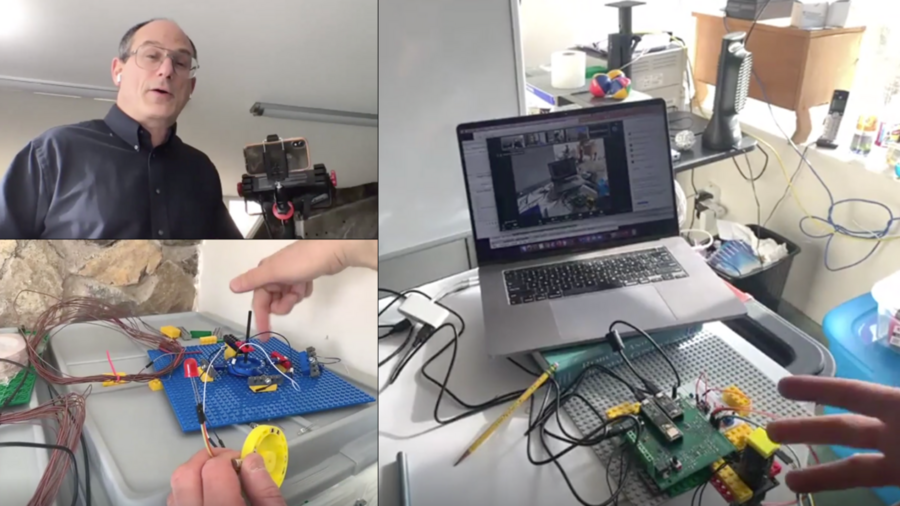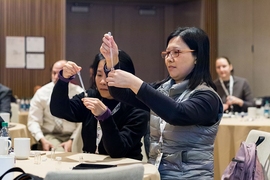When MIT’s Abdul Latif Jameel World Education Lab (J-WEL) decided to move its spring J-WEL Week online instead of canceling it outright, the organizers knew a radical redesign would present a host of challenges — and would also afford new and potentially exciting opportunities to connect education innovators at a time when it is needed most.
Held twice a year, J-WEL Week gathers over a hundred global education stakeholders, lab members, and invited guests in Cambridge, Massachusetts, providing direct access to MIT resources and developing an essential network of innovators to impact education on local and global scales. For Vijay Kumar, J-WEL executive director, canceling was never an option.
“The need was too urgent not to have it,” Kumar explains. “If anything, the public health crisis demonstrates that J-WEL’s mission of working with our members to find scalable, tech-based solutions to global problems of education access is more important than ever.”
So Kumar and his colleagues set to work translating a complex event encompassing several concurrent programs into an exclusively online format.
The team opted not to try to recreate the in-person experience. Instead, they took the opportunity to transform the gathering into something new. Steve Carson, J-WEL associate director and head of operations, remarks, “We asked ‘what can we do effectively online?’ and used that question as our jumping-off point.”
To underscore the change in concept, the convening was renamed: J-WEL Week became J-WEL Connections.
Turning challenges into opportunities
During a typical in-person J-WEL Week, delegates from J-WEL member organizations spend just under four days participating in intense sessions centered on specific topics within the lab’s three collaboratives: pK-12, Higher Education, and Workforce Learning. This is daunting enough when participants are all in one venue. Engaging members across five different continents and many different time zones presented a major technical challenge for the new format.
J-WEL Connections was expanded over the course of a month, with sessions timed so that as many participants as possible could join at once, regardless of where they are in the world. The team also mobilized to facilitate asynchronous discussions, posting recordings to the J-WEL website directly following a session, available for all members to view.
The happy result of all this spaced timing and instantaneous resource sharing is that participants who would ordinarily spend the event sequestered with their collaborative have been able to look in on sessions beyond their focus areas.
María Lucía Casas Pardo, rector of ÚNICA (Institución Universitaria Colombo Americana) in Cartagena, Colombia, took part in the pK-12 program and has attended previous J-WEL Week events. She comments, “J-WEL Connections certainly offered possibilities that were out of reach in the past, at least in real time. The richness of what was offered, and the spaces designed for meeting others, chatting, and sharing generated a sense of connectedness would have been very difficult to achieve even in a face-to-face event. While I have been able to enjoy the K-12 program, activities, and resources, I’ve connected with people from higher education and have been able to attend sessions and to access materials that have added enormous value to my experience.”
This cross-pollination of ideas will become increasingly useful as J-WEL addresses challenges that will follow learners from early childhood through their working lives.
Responding to learners’ and educators’ most urgent concerns
J-WEL strives to engage with developments in education as they are happening, so organizers quickly adjusted their programming to address the greatest and most immediate issue: the degree to which Covid-19 has placed traditional, face-to-face teaching and learning effectively on hold.
With 1.5 billion learners of all ages out of school worldwide, pK-12 senior associate director Claudia Urrea recalibrated her “Leading Learning Experiences” program to focus on mitigating the effects of the pandemic on primary and secondary education. Offerings include sessions on global citizenship and collective well-being led by J-WEL fellows Peter Senge and Miriam Mette Böll, as well as a six-week online workshop on designing learning experiences in collaboration with K-12 education researchers and practitioners from all across MIT.
Helping universities to redesign their curriculum to integrate technology effectively and maximize student engagement has been a priority area for J-WEL Higher Education, even before the pandemic. As colleges and universities all over the world move their courses online in response to stay-at-home directives, this work has become desperately important. Because much of what university educators have discovered in transitioning to virtual classrooms is applicable across grade levels, the pK-12 and higher education groups have spent time working together to find online solutions.
Workforce Learning divided its program into two tracks, the first surrounding the MIT J-WEL Human Skills Matrix, a systematic synthesis of non-technical skills that will retain their relevance in a turbulent global economy. “Learners and workers alike need to brace for a future of work where labor market needs are ever-changing or unknown, particularly when it comes to technical skills,” says Workforce Learning Assistant Director Susan Young.
The second track focuses on new research into career advice. Says Principal Research Scientist George Westerman, “If we help people to see what’s possible for them, they can be more engaged in choosing — and benefiting from — the right learning experiences.”
Agile models for current challenges and future needs
Now over halfway through its run, J-WEL Connections gives every indication of having succeeded on its own terms. “While we desperately miss the opportunity to collaborate with our members in person, there have been several advantages to our all virtual platform,” Carson says. “In part because of the online format, we were able include more representatives from our member organizations.” By the end of the second week, over 280 people had registered, making J-WEL Connections the lab’s largest convening ever. There were 1,957 total session attendances, and over 500 views of recorded video sessions.
As Carson notes, it helps that J-WEL comes pre-equipped with technical expertise: the lab has been hosting complex online convenings, such as interactive webinars, nearly since its founding in 2017. But what really makes J-WEL Connections valuable is the thoughtful and enthusiastic engagement of participants across time zones.
Although Sylvia Schmelkes del Valle, participating from Universidad Iberoamericana in Mexico City, felt a “little shy” when first using conferencing technology to network with colleagues online, she has found her overall experience to be deeply enriching: “This event has led me to think about the things we can do without having to travel so much and use up so much fossil fuel, transit time, and time lost to jet lags. It has undoubtedly also allowed us to reflect on our work in universities, and on how to make the most of face-to-face classes, as well as what technology has to offer.”
J-WEL Connections may provide a model not just for reacting to present circumstances, but for meeting future needs. As Kumar observes, “This could well be a microcosm of the future ahead.”









